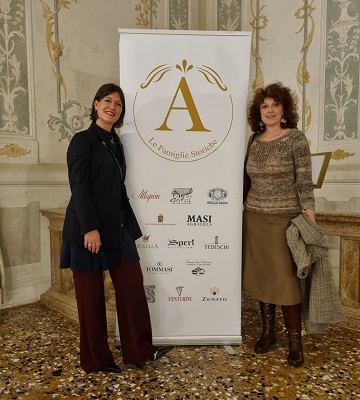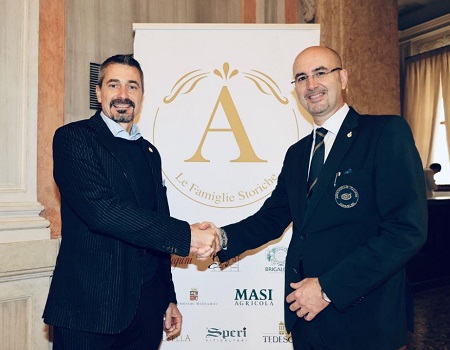Historic Families, if wine were a perfume

Let's talk about Amarone and a tasting done by our enologist-taster Sissi Baratella together with her friend "nose" (as perfume creators are called) Joan Giacomin, trained to recognize each fragrance.
Although the scent of Amarone has not yet managed to tire me, in fact each time is almost as if it were the first time... I must say that the desire for new experiences certainly does not fail me. So I took advantage of it by making unwitting guinea pigs of my latest experiment the Famiglie Storiche, that is, the 13 wineries in Valpolicella that have made Amarone their standard-bearer.

After smelling more than fifty different scents and composing my own personal fragrance (which currently rests in the refrigerator waiting for it to become unique) we went to the tasting. I'll break a lance in my favor, Joan's nose works sublime and fascinatingly, the more trained palate of the two however was mine. Wine tasting, evidently, includes an aspect that is not expected in perfumes, namely that of swallowing, which can give, as we had confirmation during our experiment, solid confirmations rather than unexpected and conflicting sensations.
We begin by trying to make sense of things by defining concepts.
Joan teaches me that the nose of a perfume must divide into three basic components:
- top notes, those that are the freshest but also destined to last the least in terms of both life and duration of perception. These include lemon, bergamot, mandarin, anise and lemongrass, just to give you examples.
- heart notes, of medium duration make up the body of the fragrance. Warm and enveloping, mostly gourmand and in some respects gastronomic. There are white flowers here, but also peach, pear, raspberry, as well as sweet spicy notes of cinnamon, clove, nutmeg.
- base notes, constitute the backbone, they are the most persistent, a real sort of scaffolding. We distinguish patchouli and vetiver, as balsamic deep notes, but also vanilla and tonka bean (my recent obsession...).
 When still all these components are present and therefore recognizable, the nose is said to be three-dimensional. Rich therefore in facets but above all in depth. A perfume also may be traceable to a particular historical era, where certain fragrances were literally in fashion rather than others. Guess instead what in the world of perfume, and fortunately increasingly in the world of wine as well, is out of fashion and now forbidden? Making a distinction between men's and women's perfumes as well as talking about oriental fragrances. In short, there are no more boundaries and anything is possible.
When still all these components are present and therefore recognizable, the nose is said to be three-dimensional. Rich therefore in facets but above all in depth. A perfume also may be traceable to a particular historical era, where certain fragrances were literally in fashion rather than others. Guess instead what in the world of perfume, and fortunately increasingly in the world of wine as well, is out of fashion and now forbidden? Making a distinction between men's and women's perfumes as well as talking about oriental fragrances. In short, there are no more boundaries and anything is possible.
Hoping to have made you want to know so how it went with the wine... here are some pearls (the most striking ones) that with Joan we shared during the tasting of the Historical Families wines.
Azienda Speri, Amarone della Valpolicella Classico Sant'Urbano 2018. It was floral, with notes of mimosa and damascenone (coded as cellar rose, that is, a hint that smells of rose but also of cellar attributable to aging in wood). In the background is a root note. All of their wines (Valpolicella Superiore and Valpolicella Ripasso were also present) are marked by great savoriness, an element that may depend on red algae.
Confused? Let's proceed...
Tenuta Sant'Antonio, Amarone della Valpolicella Campo dei Gigli. Called a masterpiece from an olfactory point of view. Smells of ambergris, which I honestly don't remember what it is, I stopped at "masterpiece."
Tedeschi, Amarone della Valpolicella Marne 2019. It has notes of galbanum, which for the record is a resin. I traced it back to that green, fresh note that I always recognize in Tedeschi's wines from Tenuta Maternigo. It is a freshness quite different from that of the 2013 Amarone della Valpolicella Classico Riserva Capitel Monte Olmi, in which Joan identified Helvetolide (the name of a synthetic, patented aroma), a scent coded as "open window to nature." Not bad huh?
Shall we move on? Of course we are!
Brigaldara. Amarone della Valpolicella Classico has been described as smelling like late 1800s. While Amarone della Valpolicella Case Vece 2016 tastes of tonka bean (I happen to find this scent I discovered I love in the very wine I normally prefer from Brigaldara), jasmine absolute and blond wood. Two decidedly different wines for the same winery, on the other hand one is from grapes from the classic zone the other is not.
Tommasi, Amarone della Valpolicella Classico Riserva De Buris 2010. Joan found it to be the only three-dimensional wine in the tasting. So really very interesting and deep on the nose. I would add that all Amarone from the Tommasi family are very rich on the nose and above all immediate. They don't have to be sought in the glass, they come to you and that helps to make them decidedly appealing.
What do you say? One more company?
Allegrini. Let's start with the definition of Amarone della Valpolicella Classico Riserva Fieramonte 2013, the wine with the invisible aroma that brings two experiences together. It announces one thing, then tells you another. Invisible because it is reminiscent of mountain yogurt, so very fatty and acidic and sweet tasting at the same time. A scent of something that is obviously not there but can be smelled. To finish the Recioto della Valpolicella Classico Giovanni Allegrini 2016 in which a lactic note prevails therefore sweet reminiscent of coconut and milk as well as cream.
In my opinion this time, in addition to thirst, I may have made you hungry as well.
I will stop here, but I am not even halfway through the Families, so we will make up for it in the next tasting. I leave you with tasting notes of two wines that I have never reviewed publicly but were present at the event and left me with excellent memories. To read more, click on the name.
- Brigaldara Valpolicella Superiore Case Vecie 2020
- Allegrini Recioto della Valpolicella Classico Giovanni Allegrini 2016
PS. The occasion for this tasting, served on a silver platter, was an event organized by the Families in collaboration with Ais Veneto in beautiful Venice. Venue of excellence the Hotel Monaco, in all its Venetian magnificence.
Related Products
| Product | Producer | Date of publication | Author | Read | |
|---|---|---|---|---|---|

|
Giovanni Allegrini 2016
Recioto della Valpolicella |
Allegrini | 01/12/23 | Sissi Baratella | |

|
Allegrini
|
01/14/16 | Redazione |
This is a great brand for Verona wines and offers a vast selection of wines. At the beginning Fieramonte was a cru that represented the feather in the estate’s cap but its production was... Leggi tutto |
|

|
Case Vecie 2020
Valpolicella Superiore |
Brigaldara | 01/12/23 | Sissi Baratella | |

|
Brigaldara
|
03/01/22 | Redazione |
The Brigaldara winery is in the heart of Valpolicella in the Valla di Marano north of Verona, one of the four valleys that constitute the classic area of Valpolicella. Amarone is their top product,... Leggi tutto |

 Italiano
Italiano







